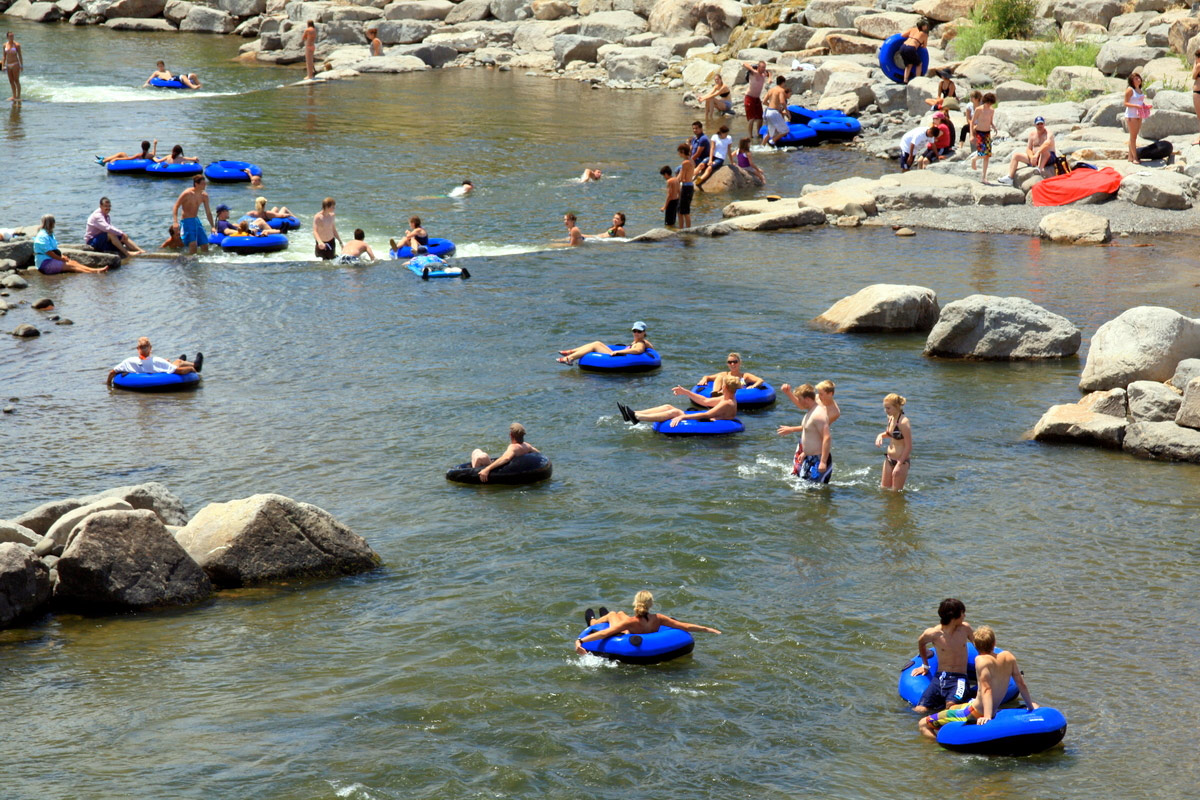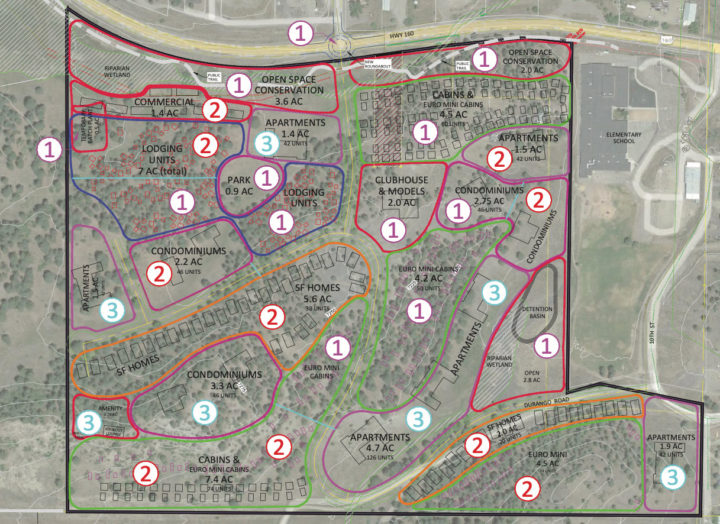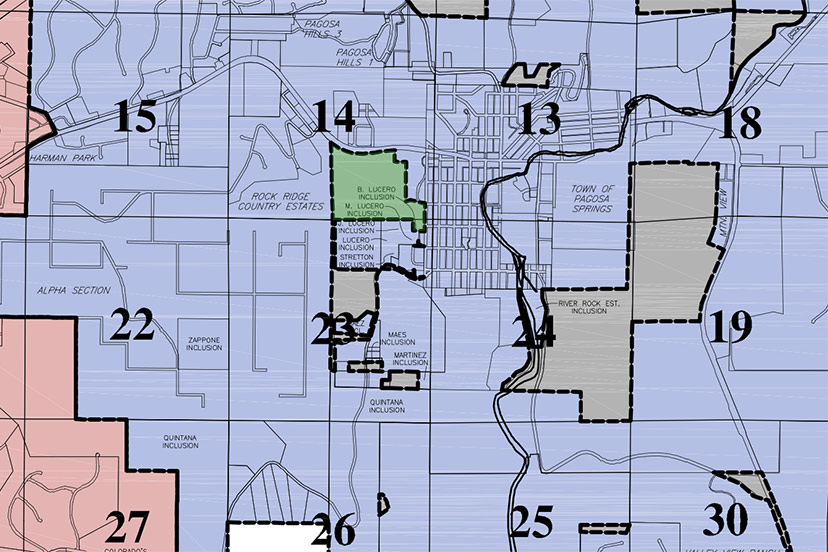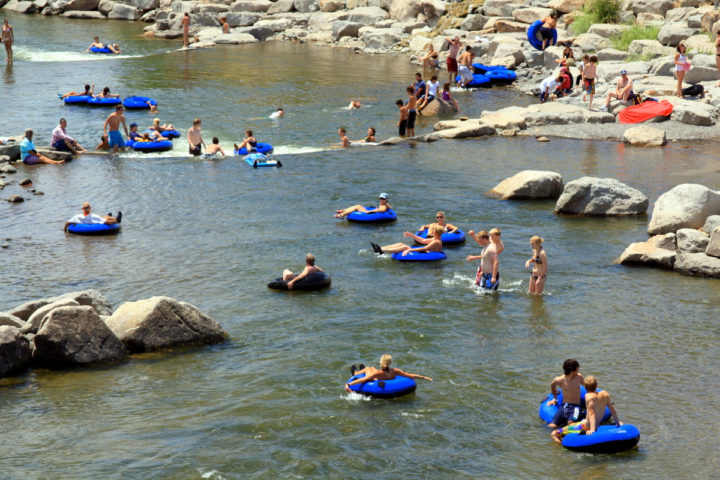In Part One, we discussed, briefly, the Pagosa Area Water and Sanitation District (PAWSD) board meeting on Thursday, where the board considered a request from Village Care Partnership LLC for a ‘Will Serve’ letter. The requested letter would provide some kind of assurance for potential financial lenders, that PAWSD has enough raw water, and infrastructure, to serve ‘Pagosa Views’ — an 80-acre subdivision proposed for vacant land immediately west of the Pagosa Springs Elementary School. (You can click the map below for a slightly larger version.)
According to the latest numbers provided to PAWSD, the subdivision will ultimately include:
- 675 dwelling units of various sizes.
- A clubhouse, which will include a bistro and bar that will be open to the public.
- Lap pool, sitting pool and hot tubs (open to the public).
- Splash pad for children, along with a playground and other shared amenities such as BBQ gazebos, horseshoe pits.
- Outdoor theater (open to the public).
- Cabin lodging business (144 units) for nightly and weekly rental.
- Undefined future commercial buildings.
Presumably, all of these proposed buildings and amenities will be served by treated PAWSD water.
At Thursday’s meeting, the PAWSD board directed staff to compose a draft “Will Serve” letter, to be reviewed by the board and by the District’s attorney. The letter will include several stipulations — the main one being a requirement that the vacant property apply for inclusion, and be included, into the District.
The parcel in question (shown below in green) is one of several vacant parcels never included in the PAWSD district (shown in gray) and thus have not been paying taxes or fees to support PAWSD operations. Inclusion of ‘Pagosa Views’ will no doubt have a sizable price tag attached?
Disclosure: I currently serve on the Pagosa Area Water and Sanitation District (PAWSD) board of directors, but this editorial reflects only my own personal opinions, and not necessarily those the PAWSD board as a whole.
Some PAWSD customers might wonder whether our community has access to sufficient water and sewer treatment capacity to accommodate another 675 homes, 144 lodging units, and various businesses and amenities.
Should the PAWSD board agree to serve this new subdivision… in the midst of what the mainstream media is calling a ‘millennial drought’?
At Thursday’s meeting, board member Glenn Walsh made the following comments about the requested ‘Will Serve’ letter.
“If we’re using the Town’s ‘Will Serve’ letter as a template, that’s not very problematic, because it doesn’t extend any assurances whatsoever, that I can see.
“And the Town is dealing with the waste water issue… which is pretty daunting. But we’re dealing, specifically in this ‘Will Serve’ letter… we have adequate water rights and storage. This project fits within our demand projections…
“I can see the ‘Will Serve’ letter happening fairly quickly, but I do not see the inclusion agreement happening very quickly…”
When I was researching the PAWSD water rights last week, I totaled up two types of water right: direct diversion rights, and storage rights. Direct diversion rights flow into a reservoir or treatment plant, and then out into the community. Storage rights allow PAWSD to hold water ‘in reserve’ for long-range planning, and for situations where direct diversion is insufficient.
Last year, PAWSD sold about 1,350 acre feet of treated water. If we convert that amount to ‘cubic feet per second’, 1,350 acre-feet per year is equal to about 2 CFS. That amount serves about 7,100 residential homes and several hundred businesses.
PAWSD appears to have about 82 CFS worth of direct diversion rights, and over 5,000 acre feet of storage rights. Not all of those rights are currently in use, considering we are selling only about 2 CFS of water (averaged out over a year).
The proposed ‘Pagosa Views’ project would — over the eight-to-ten years projected for full build-out — increase the number of PAWSD homes by less than 10%. We could estimate that the ‘water sold’ might increase from 1,350 acre feet to maybe 1,480 acre feet. That amount of water — 1,480 acre-feet — would be less than PAWSD sold in 2001, prior to the devastating 2002 drought and Pagosa’s concerted (and ongoing) efforts to conserve water.
As Mr. Walsh noted, the ‘Pagosa Views’ subdivision fits rather easily into PAWSD estimates of future growth, and into its existing water resources. (Especially in a wet summer, like we are having right now.) He suggested that an aggressive construction of homes at ‘Pagosa Views’ would reduce the demand for homes elsewhere in the community.
But most of the water used in a typical home — from washing, showers, toilets — eventually ends up in the sewer system. ‘Pagosa Views’ sewage will ostensibly end up in the Town’s seven-mile-long sewer pipeline, to be pumped uphill to the Vista Waste Water Treatment Plant… operated by PAWSD.
Mr. Walsh noted the challenges posed by the shared sewer system.
“I see less problem with a very broad ‘Will Serve’ letter. We have the raw water, the water rights and the storage. It’s within our demand profile and all of our projections, which project, as you go forward, up to 165 new EUs (‘Equivalent Units’) per year. This would essentially four years worth of growth, spread over ten years…
“So on the water side of things, it’s just a matter of engineering, and money.
“But, boy, on the waste water side of things, I have to say that the idea you could fit Phase 2 or Phase 3 into the existing system, must rely on some highly theoretical computation of what this [sewer] system can handle. Because, right now, the Town is building two overflow ponds, and lining up 25 or 30 contractors to truck overflow waste up to our facility.
“And the idea that you can add another 80% of flows to a system that is already failing — I mean, failing to a point where the Town is contemplating building a new [sewer plant] and just scuttling the whole [pipeline] system — boy, that one is hard for me to believe…”
A general assumption, in modern America, is that ‘growth’ can be accommodated successfully in most any community, given enough engineering and money. Not only that growth can be accommodated, but that growth will ultimately make the community more healthy, economically.
The truth of the matter is that — looking at the history of the past 50 years in Colorado — growth can indeed be accommodated, but ultimately, many workers — working families and individuals — will be driven out of town by the rising cost of living.
That unfortunate effect can be seen in nearly every tourism-driven mountain town on the Western Slope.
A new report from Region 9 Economic Development claims that the cost of living in Pagosa Springs is already beyond the reach of a typical working family…
The 2022 Colorado minimum wage is $12.56 per hour, which amounts to $26,527 per year working full time. We found that in Region 9, Montezuma County is the least expensive ($71,292 annually), and Archuleta County is the most expensive place to live ($92,796 annually) for a family of four. Using housing and childcare costs specific to each community we found that the Town of Pagosa Springs is also the most expensive community in the region for a family of four ($21.97 per hour for each working adult) due to the high cost of housing…




